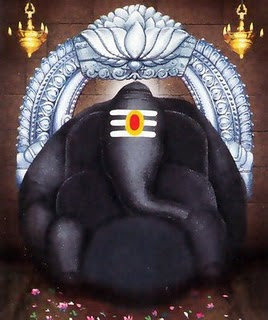Temple Story of Kanipakam
The Temple, initially erected during the early 11th century CE under the reign of Chola king Kulothunga Chola-I, underwent significant expansion in 1336 by the Emperors of the Vijayanagara dynasty. Within the annals of this ancient sanctuary lies an enthralling legend—a sthala purana—that spans a millennia.
News of this miraculous find spread like wildfire among the villagers, prompting a fervent response. Throngs of people rushed to the site, bearing coconuts and sacred materials for worship. Thousands of coconuts were shattered, their nourishing water extending across one and a quarter acres—an act known in the local dialect as "Kani." Henceforth, the place earned the moniker "Kanipakam." Even today, the well enveloping the Sri Varasiddi Vinayaka Idol remains, with water perpetually surrounding the deity. The head injury on the Idol remains visible, an enduring testament to the legend's origins.
The sanctified water surrounding the Idol serves as theertham, offered to all visiting devotees. Kanipakam, where Sri Vinayaka Swamy emerged as "Swayambhu," lies adjacent to the Bahuda River. According to ancient lore, the river earned its name "Bahuda" following Lord Vinayaka Swamy's self-elevation at Kanipakam.
Legend speaks of two brothers, Sankudu and Likhithudu, on a pilgrimage to seek Darshan of Lord Swayambhu Sri Vinayaka. Along their journey, the younger brother, Likhithudu, exhausted and famished, desired a mango from a tree. Despite warnings from Sankudu, he consumed the fruit, claimed by the king. Sankudu reported the theft, leading to a severe decree from the king: both hands of the younger brother were to be amputated.
Deeply saddened by this turn of events, Sankudu sought solace in a holy bath in the river near the Swayambhu Vinayaka Temple before seeking Darshan. As the brothers immersed themselves in prayer, a miraculous event unfolded—the younger brother's hands were restored. Overwhelmed with gratitude, they sought Darshan of Lord Vinayaka Swamy, offering vows in gratitude for the blessing. Their testimony of the deity's benevolence spread among neighboring villagers, leading to the river being named "Bahuda," symbolizing the spot where Lord Vinayaka gifted Likhithudu his lost hands.
Traditions of Resolution and Spiritual Practices at Kanipakam Temple
At Kanipakam Temple, disputes find resolution through a unique practice—a "Special Oath." Individuals embroiled in conflicts arrive seeking reconciliation, partaking in a sacred ritual at the temple tank. Swearing before the deity, known as "Pramanam," holds immense significance, where a sworn statement about an incident is regarded as the ultimate truth. This age-old tradition serves as more than a mere court judgment, often facilitating the settlement of numerous disputes. However, false swearing invokes the wrath of Sri Varasiddi Vinayaka, who ensures just retribution. Temple authorities collect a nominal fee of Rs. 516/- for conducting this ceremony daily, offering a platform for justice and resolution.
Ancient Vedic texts praise Sri Varasiddi Vinayaka as possessing the qualities of gods, gandharvas, demons, and humanity. Described in the 'Adarvaseershopanishath' as the embodiment of Parabrahma—the absolute Paramathma—devotees seek blessings through the 'Ganapati deeksha.' This sacred practice spans 41 days (Mandalam), 21 days (half mandalam), or 11 days (Ekadasa), akin to Swamy Iyyappa or Lord Sivadeeksha. Commencing at any Ganesh temple, the Sri Ganesh Deeksha culminates exclusively at Sri Varasiddhi Vinayaka Temple in Kanipakam.
Notably, the main deity, Moola Vigraha, faces an unusual northern direction, a rarity in deity orientations. A peculiar phenomenon occurs as the first rays of the sun illuminate the Lord's feet, gradually fading as they reach the deity's head, marking a unique spectacle at the temple.

